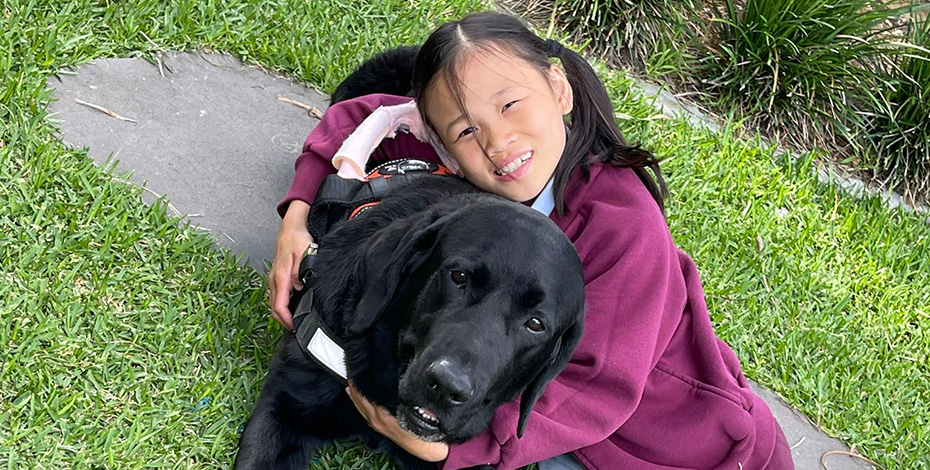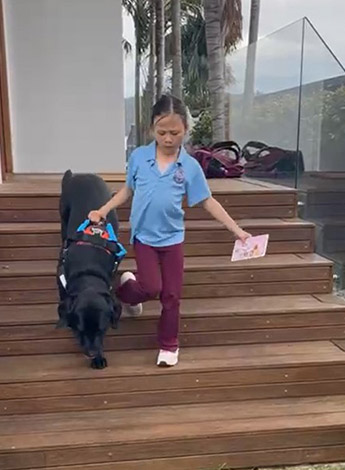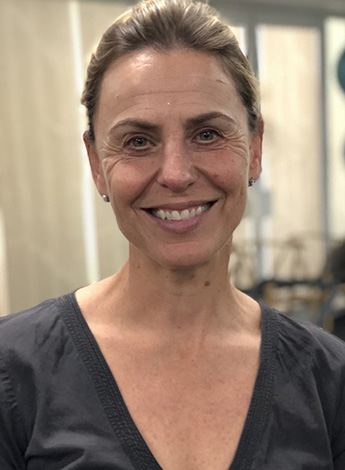
Gait training gives paws for thought

As a sole private practitioner running a small clinic in the Northern Beaches region of Sydney, Cathy Molloy hadn’t much considered undertaking a research project until a little girl with hereditary spastic paraparesis walked into her clinic. With some lateral thinking, a motivated parent and a dog named Checkers, Cathy embarked on a case study.
Having spent most of her career in a bustling and collaborative public hospital environment, Cathy Molloy APAM MACP branched out as a sole private practitioner and had been going it alone for six years when she began questioning whether she was keeping up with the current paediatric physiotherapy research.
So she decided to undertake a Master of Advanced Paediatric Physiotherapy Practice through Monash University to solidify her skills and to ensure that she could offer the best to her young clients and their families.

Tackling stairs together was key to assessing the progress of Chloe’s balance, with her canine companion helping out.
‘Because I’m a sole trader, it can be tricky to know whether I’m actually doing the right thing every time by all of my little ones.
'So it was good to get the most up-to-date evidence to confirm that what I’m doing is the right thing and to make sure that I’m touching on all areas of paediatric physio,’ says Cathy, an APA Paediatric Physiotherapist.
‘I wanted to know that I could be comfortable treating whoever came through my door.’
The small research component of her advanced clinical practice postgraduate degree sparked an interest in research more broadly, but there was the business to run and the client list to maintain.
Then eight-year-old Chloe and her physiotherapist mum Michele walked through the clinic door and an idea began to take shape.
That idea morphed into a case study on the effects of gait training with an assistance dog on falls and balance in a child with hereditary spastic paraparesis, a case study that Cathy, Chloe and a five-year-old black labrador called Checkers completed in September last year.
‘Chloe’s mum came across some research in Canada that looked at adults with ataxia and the effects of an assistance animal versus the effects of a static gait aid on gait parameters and balance.
'And the research showed that for adults with ataxia, walking with an assistance animal was superior to walking with a static frame in terms of outcome measures, number of falls and muscle activation patterns and it had a less destabilising effect on their gait than a static frame did,’ Cathy says.
‘Chloe’s mum said to me, “Chloe’s eventually going to need a frame, what do you think about an assistance animal?
'Is this something that the National Disability Insurance Scheme may be able to help us with?”’
Cathy began reviewing the research, which she found to be sparse.

Chloe holds on to Checkers’ harness during a toe tap exercise.
She discovered that in 2016, La Trobe University had conducted a literature review, commissioned by the National Disability Insurance Agency, on assistance animals.
The results showed that it was difficult to make recommendations for an assistance animal for mobility because the studies available had methodological flaws and were small in number.
Cathy decided to seek help to conduct a small case study of her own, using Chloe as the case report.
‘I wanted to see if there would be any effects on Chloe from a body systems and participation perspective.
'We needed some help with research - and we needed a dog.
'We contacted CP Quest, which is part of Cerebral Palsy Alliance and which helps people with lived experience of disability partner with research activities.
'We were very lucky to have Dr Sarah McIntyre, the senior research fellow at CP Quest, agree to help us out,’ Cathy says.
‘She helped us contact the Canadian researcher who had done that study with atactic adults and we got some good information about how we could come up with a case report to see what effects an assistance animal would have on Chloe’s walking ability.
'The next task was to get a dog. We were also very fortunate to have Guide Dogs Australia come on board.
'The therapy support coordinator Samantha O’Keefe agreed to look for a dog and a handler.
'We needed a dog that was the right size, with the right temperament, and we looked into harnesses because the usual guide dog harness was not going to work for Chloe.
'It had to have a little more stiffness to it and we needed to make sure that the harness was around the dog’s shoulders and not around his neck.
'And the dog had to come to Narrabeen, where Chloe lived, so we could do the training in Chloe’s real environment.’
Having not quite made the grade as a seeing eye dog, Checkers had instead been helping victims of crime who had to attend court hearings.

Cathy Molloy.
As part of the Canine Court Companion Program, run by Guide Dogs NSW/ACT and Victims Services, Checkers, along with his handler Gabby, worked to ease the stress of those having to attend court.
He was identified as fitting the criteria to help in the case study and Chloe and Checkers spent the first few weeks of the study getting to know one another.
Baseline data was recorded before the six-week intervention began, using the Goal Attainment Scale, the Mini-Balance Evaluation Systems Test, the 10-metre walk test, the walking Visual Analogue Scale and the Gillette Functional Assessment Questionnaire.
‘We spent time doing some general gait training and a bit of endurance walking; we would often walk up the street to the park, over different surfaces.
'It was mobility training and task-specific practice that related to Chloe’s goals, one of which was to walk upstairs using the handrail and wearing her backpack.
'So we did lots of stepping up and down and walking on the stairs with Checkers,’ Cathy says.
‘Another of Chloe’s goals was to walk from the kitchen to the dining table carrying a plate without spilling anything, so we did lots of balance work that involved dual-tasking.’
Using gameplay throughout the twice-weekly, 60-minute interventions at Chloe’s home and surrounding area, Chloe and Checkers would always end their sessions with some playtime and treats for Checkers.
Chloe also continued her regular fortnightly physiotherapy sessions with Cathy at her clinic, Just for Kids Physiotherapy.
‘Checkers loves carrots so they were his treats at the end. Chloe could give him the command to sit, put a carrot on his paw and then have Checkers wait to eat the carrot.’
While the results of the case study remain prescriptive at this stage, Cathy says there have been improvements shown in some of the outcome measures taken.
She says Chloe exceeded expectations for each of her goals.
‘We did the Gillette Functional Assessment Questionnaire, which rates items from “can’t do at all” to “easy”.
'We found that the items that were “easy” or that she was too young to do didn’t change.
'But for the items that were rated “a little hard”, “very hard” or “can’t do at all”, we did see a general trend for them to move into the less hard categories,’ Cathy says.
‘This meant that tasks she originally found she couldn’t do at all or that were very hard were actually moving towards the easier end of the scale.’
Cathy says she was surprised by the significant gains Chloe made in working towards her goals.
Assessment of the study is ongoing, with Sarah McIntyre from CP Quest assisting Cathy.
‘In terms of showing evidence to the National Disability Insurance Agency that an assistance animal is helpful for balance, it’s a really tricky one with children.
'We can show that Chloe can now walk from her house to the park without falling over.
However, the difficulty remains that having the assistance dog doesn’t negate the need for a carer because we’re talking about children.
With adults, it might reduce the care requirements if they have a dog to help with their mobility but for a child who’s only eight, we still need a carer or a parent.
I think from a National Disability Insurance Scheme perspective, we’re probably not going to move too far forward where that’s concerned at this point.
‘However, this study shows that even if you are working on your own in private practice, there are supports out there to help you engage in a small research project or case study.
'You can come up with some worthwhile information,’ she says. ‘Does it take a lot of time? Yes, it does.
'I didn’t charge Chloe for any of that and from a private practice point of view, you need to balance your time.
'But there is potential for physios in the private sector to tackle small amounts of research. Don’t be scared by it; take it on and say, “I know nothing about it—let’s learn together”.’
© Copyright 2024 by Australian Physiotherapy Association. All rights reserved.





